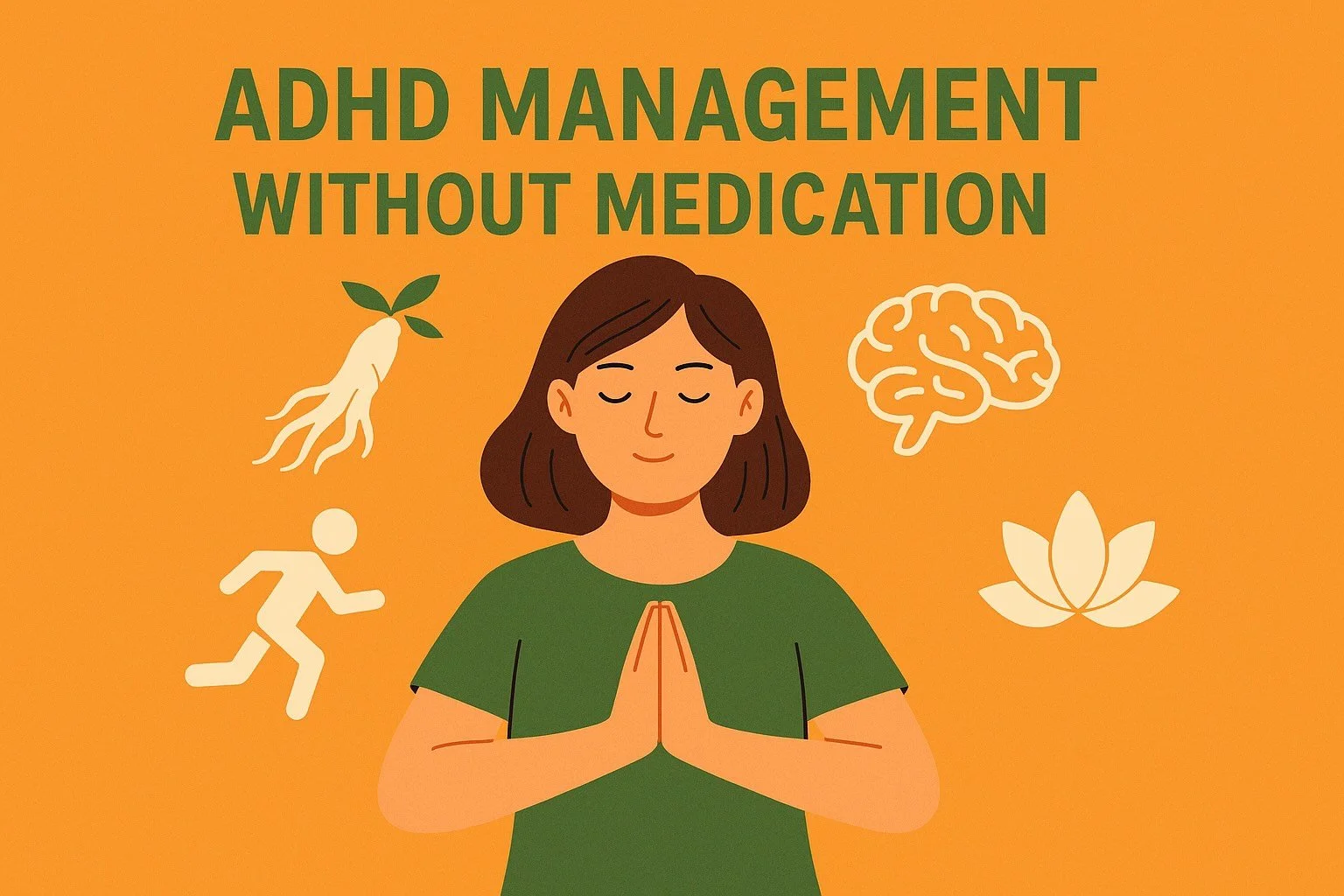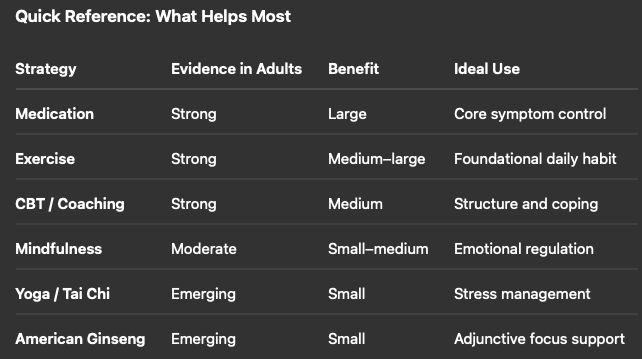ADHD Management Without Medication: What Helps The Most
Many adults living with ADHD wonder whether lasting improvement is possible without prescriptions. The good news is that effective ADHD management without medication is absolutely possible—especially when you combine behavioral strategies, movement, and mindfulness. While medication remains the most powerful treatment for reducing core ADHD symptoms, research shows that exercise, therapy, and structured routines can significantly enhance focus, motivation, and emotional regulation.
At Celium Healthcare, we take a comprehensive, evidence-based approach to ADHD care—helping adults find balance, clarity, and focus through personalized plans that work for real life.
1. Exercise: The Strongest Non-Medication Tool
If you only add one new habit, make it aerobic exercise.
What to do
Aim for 30–45 minutes of moderate-to-vigorous exercise (running, cycling, swimming, or brisk walking) three to five times per week. Shorter bursts—10 to 20 minutes—before mentally demanding tasks can also boost focus.
Why it helps
Exercise raises dopamine and norepinephrine levels—the same neurotransmitters targeted by ADHD medications. Studies in adults show that both single and ongoing sessions improve attention, working memory, and impulse control.¹
Takeaway: Exercise is the best-proven non-medication tool for ADHD. Treat it like a prescription for your brain.
2. Mindfulness and Meditation: Attention Training for the Mind
Mindfulness meditation helps you notice distraction and gently bring your attention back. Over time, it strengthens the brain’s ability to focus and self-regulate.
What to do
Try a structured 8-week mindfulness program (such as Mindfulness-Based Cognitive Therapy, MBCT), or start with 10–15 minutes of guided meditation daily.
Why it helps
Adults who added mindfulness training to usual treatment showed greater improvement in ADHD symptoms, emotional regulation, and stress tolerance than those who continued standard care alone.² ³
Takeaway: Mindfulness won’t “fix” ADHD, but it gives you tools to stay calm and intentional when your attention drifts.
3. CBT and ADHD Coaching: Systems That Stick
If exercise primes the brain, Cognitive Behavioral Therapy (CBT) and ADHD coaching give it structure.
What to do
Enroll in CBT for ADHD—typically a 10–12 session course—or partner with an ADHD coach for accountability and day-to-day organization. Focus areas often include task initiation, planning, and emotional regulation.
Why it helps
CBT has strong evidence for improving adult ADHD symptoms, even for those already on medication.⁴ Group and internet-delivered formats work well, too.
Takeaway: CBT and coaching build the habits and routines that medication alone can’t teach.
4. Yoga and Tai Chi: Calming the Body, Focusing the Mind
Mind–body movement practices like yoga and tai chi combine attention, balance, and controlled breathing—three areas that often challenge people with ADHD.
What to do
Commit to two to three sessions per week. Choose classes that emphasize steady pacing and mindful breathing.
Why it helps
A 2024 systematic review found yoga and tai chi can improve attention, executive function, and stress regulation in ADHD populations.⁵
Takeaway: These slow, rhythmic practices help quiet a restless body and steady a racing mind.
5. American Ginseng: A Complementary Option Worth Watching
Among herbal approaches, American ginseng (Panax quinquefolius)—especially Hsu’s Brand—has drawn attention for potential cognitive benefits in ADHD.
Expert perspective
Psychiatrist Dr. Richard P. Brown, an expert in complementary therapies, reports that Hsu’s Brand ginseng works faster than others:
“People feel it working right away. They process information a little better. One patient told me, *‘It’s like going from an old-fashioned TV to high definition.’”⁶
Mechanism of action
American ginseng contains ginsenosides, plant compounds that influence acetylcholine and glutamate signaling, and provide neuroprotective and anti-inflammatory effects in the central nervous system.
What the research shows
Controlled studies have found American ginseng can improve working memory and mental processing speed, sometimes within hours, with effects lasting over several months.⁷
How to take it
Start: 1 capsule each morning for one week.
Increase: 1 capsule morning and noon.
Adjust: Up to 2 capsules twice daily if tolerated.
Example product: Hsu’s Brand American Ginseng on Amazon
Safety considerations
Ginseng is generally safe but may cause insomnia, anxiety, or headaches in some people. It can also increase bleeding time—use caution if taking anticoagulants or before surgery. Always consult your clinician before starting supplements.
Takeaway: American ginseng may offer a mild cognitive lift for some adults. It’s not a replacement for medication, but can be a useful adjunct when used thoughtfully.⁶
6. Building a Plan for ADHD Management Without Medication
Think of these strategies as layers, not alternatives.
Exercise improves your brain chemistry.
Mindfulness improves awareness and emotional balance.
CBT provides systems and accountability.
Yoga or Tai Chi calms the body and focuses the mind.
Ginseng may offer an extra boost for mental clarity.
The combination of behavioral foundations and, when appropriate, medication offers most adults the best outcomes.
When to Seek an ADHD Evaluation
If you’ve long felt scattered, disorganized, or “foggy,” and lifestyle changes haven’t been enough, a formal ADHD evaluation can clarify what’s happening and identify which tools—medication or otherwise—will work best for you.
At Celium Healthcare, we specialize in adult ADHD evaluations and medication management for adults across Portland and Oregon. Whether you’re exploring non-medication options or looking for a balanced, comprehensive plan, we’ll help you find what works for your brain.
References
Mehren A., Özyurt J., Lam A. P., Brandes M., Philipsen A. (2019). Acute effects of aerobic exercise on executive function and attention in adult ADHD. Frontiers in Psychiatry
Mitchell, J. T., Zylowska, L., & Kollins, S. H. (2015). Mindfulness Meditation Training for Attention-Deficit/Hyperactivity Disorder in Adulthood: Current Empirical Support, Treatment Overview, and Future Directions. Cognitive and behavioral practice, 22(2), 172–191. https://doi.org/10.1016/j.cbpra.2014.10.002
Janssen, L., Kan, C. C., Carpentier, P. J., Sizoo, B., Hepark, S., Schellekens, M. P. J., Donders, A. R. T., Buitelaar, J. K., & Speckens, A. E. M. (2019). Mindfulness-based cognitive therapy v. treatment as usual in adults with ADHD: a multicentre, single-blind, randomised controlled trial. Psychological medicine, 49(1), 55–65. https://doi.org/10.1017/S0033291718000429
Ramsay J., Rostain A. (2016). Cognitive Behavioral Therapy for Adult ADHD. Routledge.
Cairncross M., Miller C. (2020). Mind-body exercises for ADHD: A systematic review. Frontiers in Psychology
Brown R. P. (2023). Complementary Therapy in ADHD. The Carlat Report
Ossoukhova A. et al. (2015). Panax quinquefolius improves working memory and cognition. Human Psychopharmacology: Clinical and Experimental



